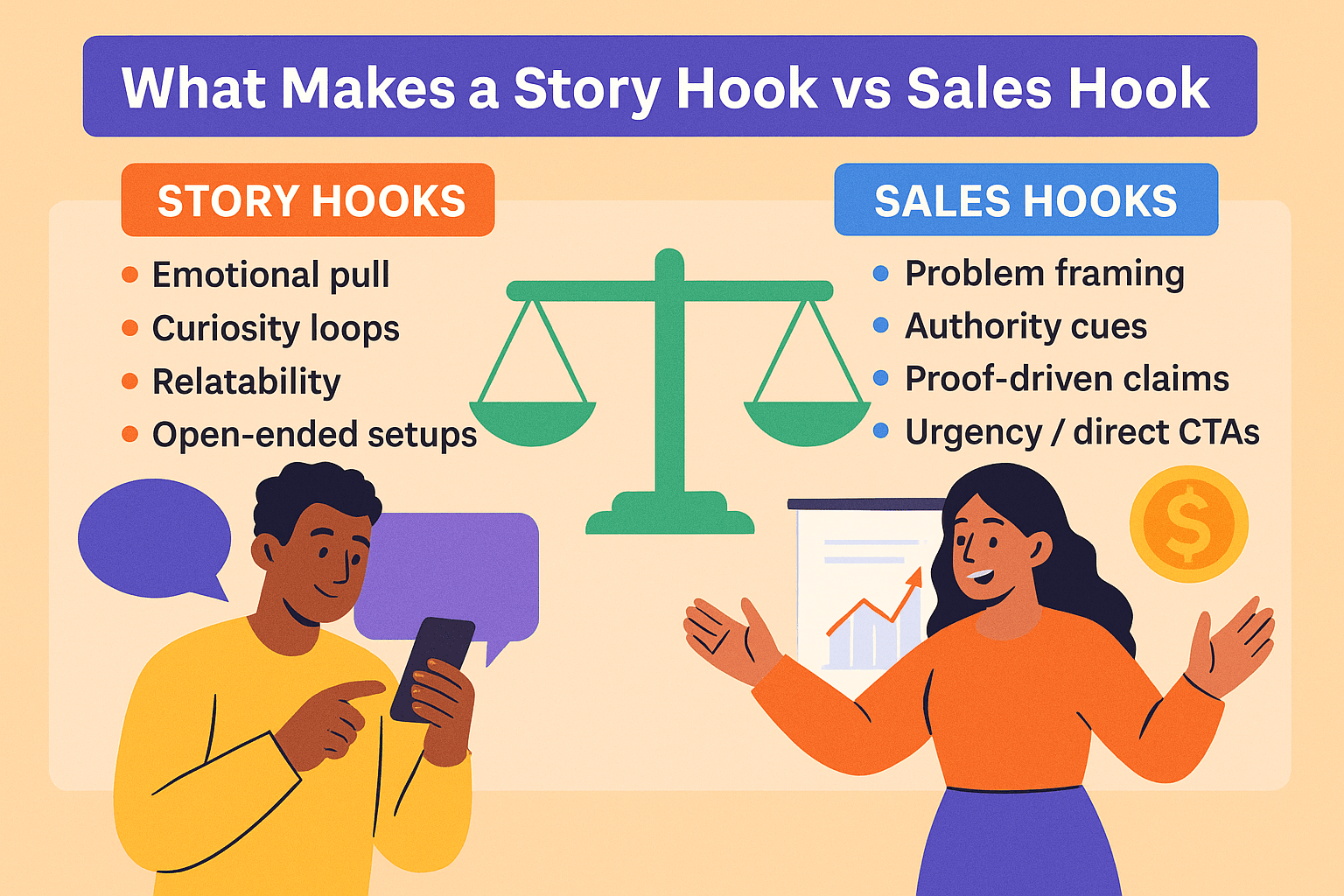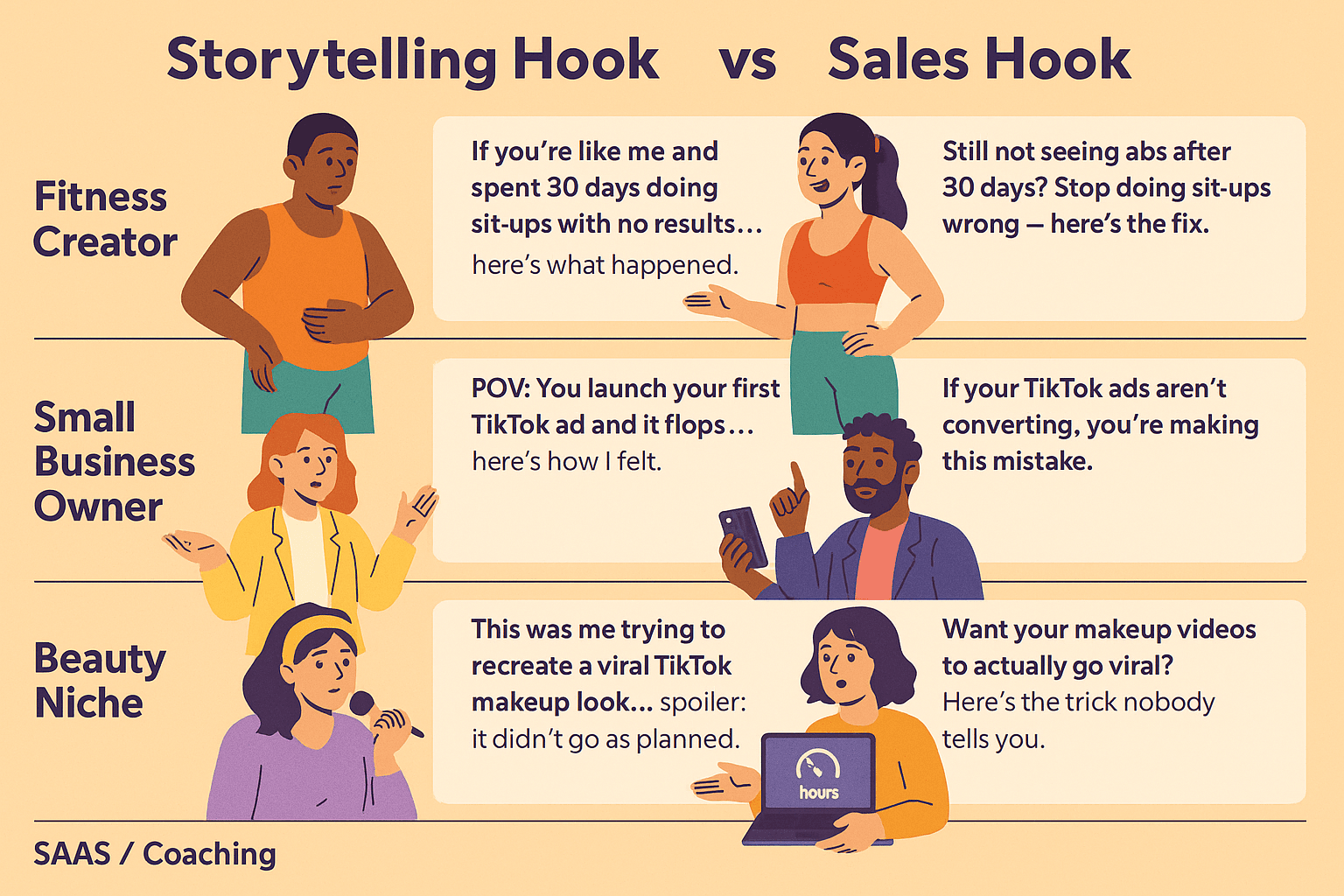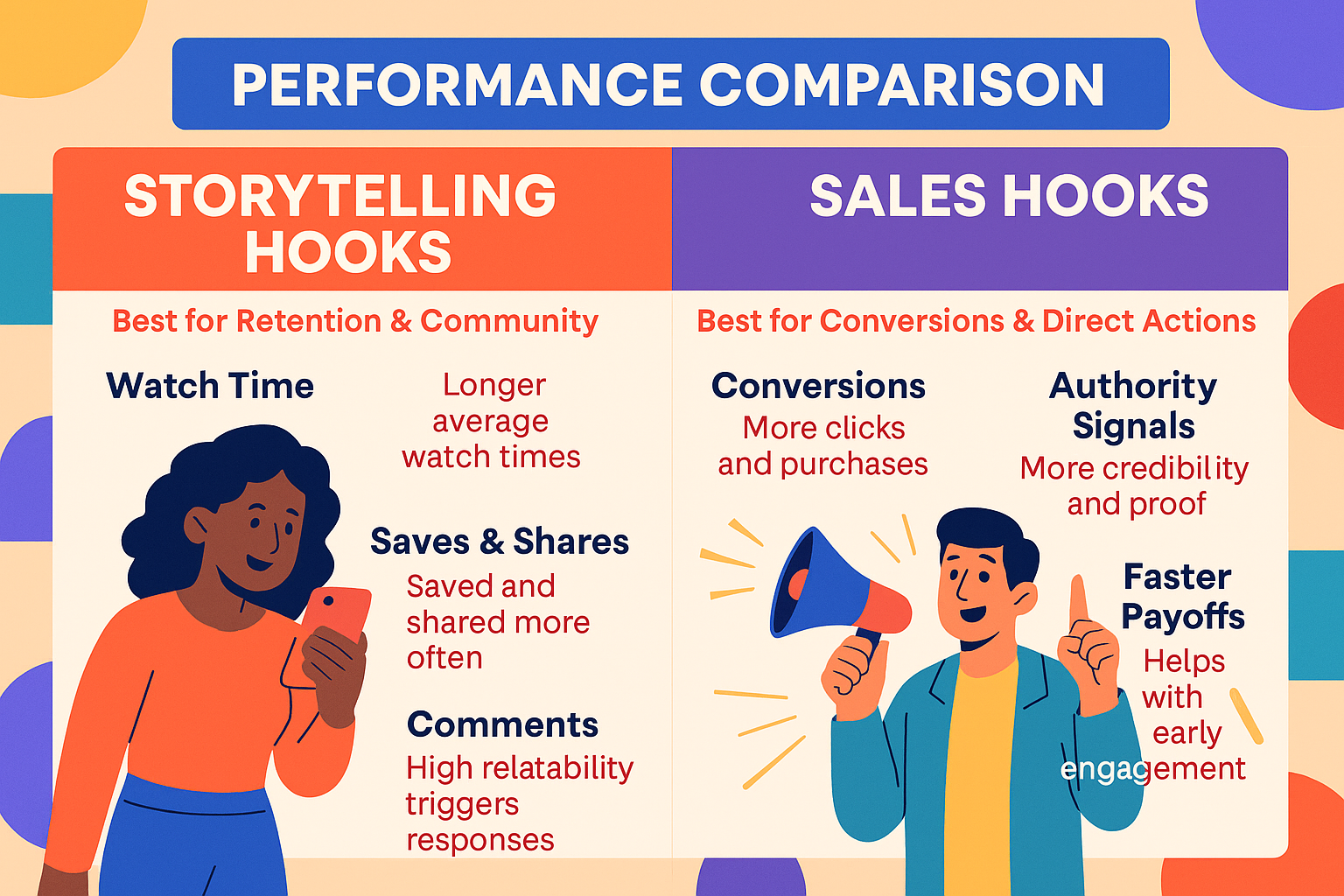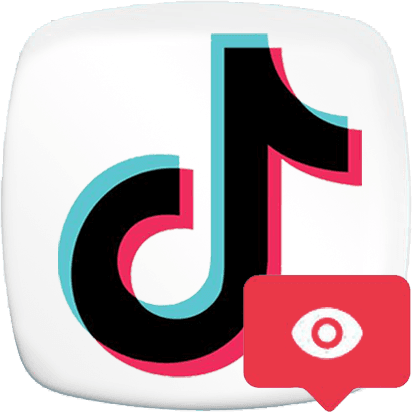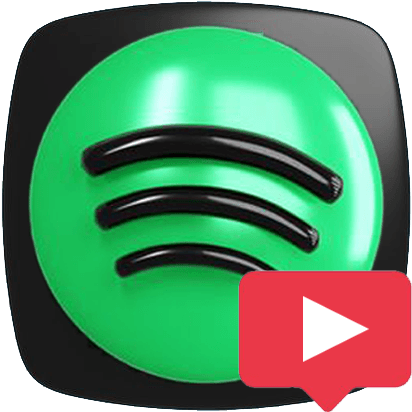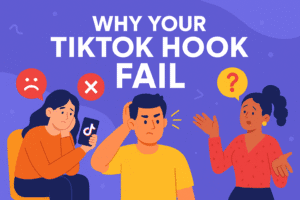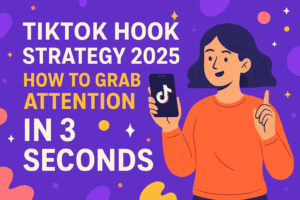What Makes a Story Hook vs Sales Hook
At first glance, all hooks seem the same: a catchy opening line that grabs attention. But in TikTok marketing, the intention behind the hook makes all the difference. A storytelling hook is designed to build connection, while a sales hook is crafted to drive conversion. Let’s break them down.
Storytelling Hooks (POV / Storytime Style)
Definition:
Storytelling hooks are emotion-driven openers that make viewers feel like they’re stepping into a moment, a story, or a personal experience. They’re commonly used in POV (Point of View) and Storytime formats, which are among TikTok’s most viral content types.
Traits of Story Hooks:
- Emotional pull → “If you’ve ever felt stuck posting daily with no growth …”
- Curiosity loops → “You won’t believe what happened when I tried this trend …”
- Relatability → “If you’re like me and hate editing for hours …”
- Open-ended setups → “So this one crazy thing happened at my job …”
Best For:
- Lifestyle creators
- Personal branding
- Behind-the-scenes storytelling
- Fitness journeys
- POV skits
Why They Work in 2025:
TikTok’s algorithm rewards watch time and saves. Story hooks keep people engaged longer because they want to see the ending. They also spark comments like “same” or “this happened to me too,” fueling community-driven engagement.
Example: Instead of “I’m going to show you a workout tip,” try:
“If you’re still not seeing abs after 30 days, this story might explain why …”
Sales Hooks
Definition:
Sales hooks are problem-solution openers designed to stop the scroll with urgency, authority, or proof. They speak directly to pain points or desired outcomes, making them ideal for product demos, coaching, or e-commerce content.
Traits of Sales Hooks:
- Problem framing → “Struggling to get clients from TikTok? Here’s why …”
- Authority cues → “I grew my account to 100k followers with this one tweak …”
- Proof-driven claims → “This hook doubled my watch time overnight.”
- Urgency / direct CTAs → “Stop wasting money on ads — do this instead.”
Best For:
- Coaches and consultants
- SaaS and digital tools
- E-commerce and product demos
- Service-based businesses
Why They Work in 2025:
TikTok is no longer just entertainment — it’s a sales channel. Users are primed to shop, book, and sign up directly in-app. Sales hooks cut through the noise by telling people exactly what they’ll gain or lose if they stop scrolling.
Example: Instead of “Here’s a tip about Instagram growth,” try:
“If your Instagram Reels aren’t getting views, you’re making this one mistake.”
Key Difference at a Glance
- Storytelling Hooks → Build connection, keep people watching, increase saves, and grow community.
- Sales Hooks → Solve pain points, deliver proof, trigger urgency, and drive conversions.
Both are powerful — but only when matched with the right content goal.
Real Examples from Each Type
The difference between storytelling and sales hooks isn’t just in the words — it’s in how you deliver them. Below are expanded side-by-side comparisons with step-by-step actions you can take to adapt them for your content.
- Story hooks focus on connection, relatability, and curiosity.
- Sales hooks focus on problem-solving, proof, and urgency.
- To maximize growth, test both versions of your idea. Story hooks may drive more saves and comments, while sales hooks drive conversions and clicks.
Example 1
Fitness Creator
Storytelling Hook (POV):
“If you’re like me and spent 30 days doing sit-ups with no results … here’s what happened.”
Steps to Action:
- Start with a shared struggle (“spent 30 days doing sit-ups”).
- Use a POV setup to make it relatable (“If you’re like me …”).
- Tease a payoff (“here’s what happened”) that builds curiosity.
- Show real before/after visuals to keep retention high.
Sales Hook:
“Still not seeing abs after 30 days? Stop doing sit-ups wrong — here’s the fix.”
Steps to Action:
- Call out the pain point directly (“not seeing abs”).
- Insert a diagnosis (“doing sit-ups wrong”).
- Position yourself as the solution provider (“here’s the fix”).
- Show a quick tip or demo in the first 5–8 seconds.
Example 2
Small Business Owner
Storytelling Hook (POV):
“POV: You launch your first TikTok ad and it flops … here’s how I felt.”
Steps to Action:
- Use “POV” to make the viewer step into the scenario.
- Set up empathy by admitting failure (“it flops”).
- Show raw reaction/emotion (a sigh, head drop, or funny caption).
- Transition into the lesson learned (“here’s how I fixed it next time”).
Sales Hook:
“If your TikTok ads aren’t converting, you’re making this mistake.”
Steps to Action:
- Identify the problem your audience faces (“ads not converting”).
- Trigger urgency with consequence framing (“you’re making this mistake”).
- Deliver proof or stat (show conversion rates, spend wasted).
- Provide a mini-fix or CTA (e.g., “optimize this setting”).
Example 3
Beauty Niche
Storytelling Hook (POV):
“This was me trying to recreate a viral TikTok makeup look … spoiler: it didn’t go as planned.”
Steps to Action:
- Use a relatable scenario (“trying to recreate a viral look”).
- Add humor or imperfection (“it didn’t go as planned”).
- Show the attempt and the fail to keep retention high.
- Engage viewers by asking: “Has this ever happened to you?”
Sales Hook:
“Want your makeup videos to actually go viral? Here’s the trick nobody tells you.”
Steps to Action:
- Lead with desire-driven framing (“want your videos to go viral?”).
- Create intrigue with insider tone (“nobody tells you”).
- Share 1 practical hack (e.g., lighting, trending sounds).
- Add CTA for engagement (“save this tip for your next video”).
Example 4
SaaS / Coaching
Storytelling Hook (POV):
“So I was stuck editing until 2am every night just to keep up with content …”
Steps to Action:
- Paint a painful, relatable image (editing late at night).
- Use story flow (“so I was …”) to feel conversational.
- Show personal frustration (coffee cup, messy desk).
- End with relief moment: “Then I found a better way.”
Sales Hook:
“If you’re wasting hours editing TikToks, here’s the tool that saves me 10+ hours a week.”
Steps to Action:
- Call out the time pain point (“wasting hours”).
- Present the solution immediately (the tool).
- Add quantifiable benefit (“saves 10+ hours”).
- Use a demo screen-recording in the first 5 seconds.
Performance Comparison: Story vs Sales Hooks
Not all hooks succeed in the same way. Storytelling hooks and sales hooks both perform well, but their success depends on what metric you care about most — watch time, engagement, or conversions. Let’s break it down.
Storytelling Hooks
Best for Retention & Community
- Watch Time: Story hooks generally produce longer average watch times, since viewers want to see “how the story ends.”
- Saves & Shares: POV and relatable stories get saved (“watch later”) and shared in DMs more often, boosting algorithmic reach.
- Comments: High relatability triggers responses like “same” or “this happened to me too.”
When to use them:
- Building personal brand
- Entertaining your niche
- Increasing organic reach and community engagement
Example: A “POV: Your ad flops on day one” video may not drive direct sales, but it creates trust and relatability — the foundation of future conversions.
Sales Hooks
Best for Conversions & Direct Actions
- Conversions: Sales hooks drive clicks, sign-ups, and purchases by calling out problems and offering solutions.
- Authority Signals: Proof-driven intros boost credibility (“I grew 100k followers with this method”).
- Faster Payoffs: Sales hooks usually front-load value, which helps with early engagement and algorithm push.
When to use them:
- Launching products or services
- Running TikTok ads or Spark Ads
- Driving traffic to landing pages
Example: “If your TikTok ads aren’t converting, you’re making this mistake” → shows credibility, pain point, and solution fast, driving conversions.
Which Performs Better in 2025?
- Storytelling hooks win on watch time, comments, and shares (strong for organic growth).
- Sales hooks win on click-throughs, conversions, and authority (strong for business outcomes).
- Smart creators test both: lead with story hooks to grow community → use sales hooks once trust is built.
It’s not about which hook is “better” — it’s about which matches your goal. Want to grow faster? Use storytelling hooks. Want to sell faster? Use sales hooks. The top TikTok creators in 2025 combine both into their content mix.
Related: Learn why weak hooks flop in our guide Why Your TikTok Hook Fail.
Match Your Hook to Your Goal
Your TikTok success doesn’t depend on luck — it depends on whether your hook matches your intention.
- If your goal is to build trust, grow community, and boost watch time, lean into storytelling hooks. POV and Storytime formats make people stay, comment, and share.
- If your goal is to sell, drive traffic, or prove authority, lean into sales hooks. They speak to pain points, highlight solutions, and move viewers toward action.
But the smartest creators in 2025 don’t choose one or the other. They combine both styles:
- Start with storytelling hooks to grow an audience.
- Layer in sales hooks once trust is built, so your message converts.
Next Steps for Growth
Want to dive deeper into TikTok hook mastery?
Read our full guide: TikTok Hook Strategy 2025: How to Grab Attention in 3 Seconds
Need help pushing your strongest hooks into the algorithm faster?
Check out our TikTok Likes Service to boost your best-performing videos with safe, fast engagement.
- Works with TikTok’s 2025 algorithm
- Helps strong hooks escape the “low view trap”
- Ideal for testing which hook formats deserve more reach
A hook isn’t just a catchy line — it’s a strategic choice. Storytelling hooks earn attention, sales hooks earn conversions. If you want to win on TikTok in 2025, don’t just use hooks — use the right hook for the right moment.
